Posts: 1,531
Threads: 242
Joined: Sep 2012
City: West Bend, Wisconsin
I started with 18 turns on the OSC primary and the radio worked up to 1200 on the dial, then cut out. Terry suggested more turns so I went to 22 turns. Turned out to be 4.0 ohm with 38 ga wire. Helped somewhat but still not getting the local station at 1470. Did notice a couple of green dots on the secondary winding which may be the cause of it cutting out. At any rate the point I was trying to make....18 turns or 22 turns, it still should work if wound the correct direction.
Greg V.
West Bend, WI
Member WARCI.org
Posts: 16,533
Threads: 573
Joined: Oct 2011
City: Jackson
State, Province, Country: NJ
I am pretty sure the direction is correct. It starts from pin 3 CCW from the bottom and ends at pin 2 after 17 or 18 turns. (Bottom/top orientation is not important).
Well, good news is, the rest of the coils, the two IF xfmrs seem to be good.
I reinstalled the oscillator coil tonight.
Maybe I can try starting sone recap tomorrow.
People who do not drink, do not smoke, do not eat red meat will one day feel really stupid lying there and dying from nothing.
Posts: 16,533
Threads: 573
Joined: Oct 2011
City: Jackson
State, Province, Country: NJ
Tonight finished all the backelite caps and some of the resistors.
The backelites proved to be very stubborn: except one the tar block would not come out and eventually break. Some different tar?
There's one tubular cap left.
The run I have seems to be the last one described.
People who do not drink, do not smoke, do not eat red meat will one day feel really stupid lying there and dying from nothing.
Posts: 13,776
Threads: 580
Joined: Sep 2005
City: Ferdinand
State, Province, Country: Indiana
Philco switched to a different type of tar (or whatever that stuff was) in the 1940s in their bakelite blocks; the latter is much harder than the previous substance.
Mike, are you using heat or are you digging the insides out of the blocks?
--
Ron Ramirez
Ferdinand IN
Posts: 16,533
Threads: 573
Joined: Oct 2011
City: Jackson
State, Province, Country: NJ
No I am still using heat. Same thing, heat up the walls and the top, and use blunt pin (I am using a small Allen wrench) to push it out. This time after repeated heating I was pushing with all my might and after 5th or 6th attempt it would start to move, barely. I was able to push out 3 out 5 as a block but still had to dislodge tar at the top, and two came out more or less fully and a bit easier.
But...speaking of 1940-s......these are 30-s...no? And...did they actually used the same backelites in 40s?
People who do not drink, do not smoke, do not eat red meat will one day feel really stupid lying there and dying from nothing.
Posts: 13,776
Threads: 580
Joined: Sep 2005
City: Ferdinand
State, Province, Country: Indiana
The vast majority of bakelite blocks are from the 1930s, yes. (To be more accurate: 1930 to 1938.)
Philco continued to use bakelite blocks as the AC line bypass or "death caps" from 1939 to 1946 or 47; possibly some 1948 models may, or may not, have one of these also. The later blocks have the very hard pitch, tar, or whatever it is...it looks and feels like a lump of coal was super glued inside the block. These too can be rebuilt by using heat to help remove the insides; it's just a bit tougher to get the old stuff out of these.
If Philco made replacement blocks for the older radios between 1939 and 1948, these would also likely have the harder material inside.
--
Ron Ramirez
Ferdinand IN
Posts: 16,533
Threads: 573
Joined: Oct 2011
City: Jackson
State, Province, Country: NJ
Yep, the Death cap block was one of those hard to push out (surprisingly the large one, the only one was one that came out better, though still with higher than normal effort). Also they used the one death cap in this radio. I put two of them in to make it a usual two Y-cap solution, considering the other AC wire come soldered to the free terminal as a "convenience soldering post" so everything's been set up for it, except the block is slim so I had to really push the caps apart to create the space between the leads.
People who do not drink, do not smoke, do not eat red meat will one day feel really stupid lying there and dying from nothing.
Posts: 16,533
Threads: 573
Joined: Oct 2011
City: Jackson
State, Province, Country: NJ
Forgot to mention, obviously the power switch is not working. But the volume pot itself from end to end is good, 300K as prescribed. Will have to open anyway, to lube and to clean the switch.
People who do not drink, do not smoke, do not eat red meat will one day feel really stupid lying there and dying from nothing.
Posts: 16,533
Threads: 573
Joined: Oct 2011
City: Jackson
State, Province, Country: NJ
Finished recap, recarb and tone control. I only replaced 3 resistors. The block cap took me 15 minutes, tone ctl - same.
If not for coils, this is very nice radio to deal with, not crowded, good access to everything.
People who do not drink, do not smoke, do not eat red meat will one day feel really stupid lying there and dying from nothing.
Posts: 16,533
Threads: 573
Joined: Oct 2011
City: Jackson
State, Province, Country: NJ
Some pics:
Before recap
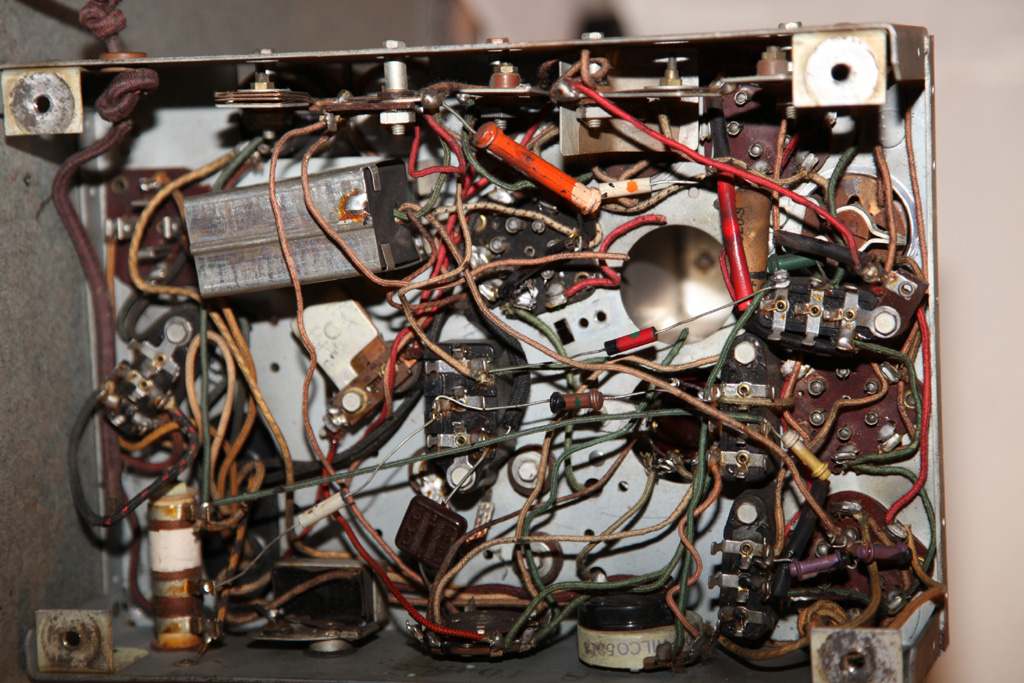
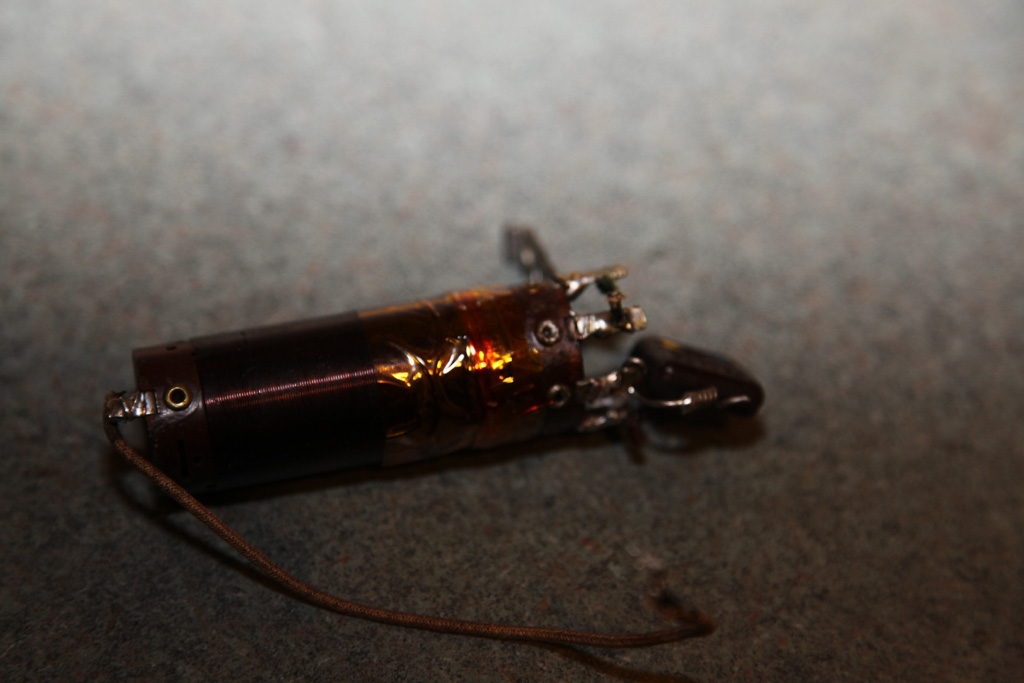
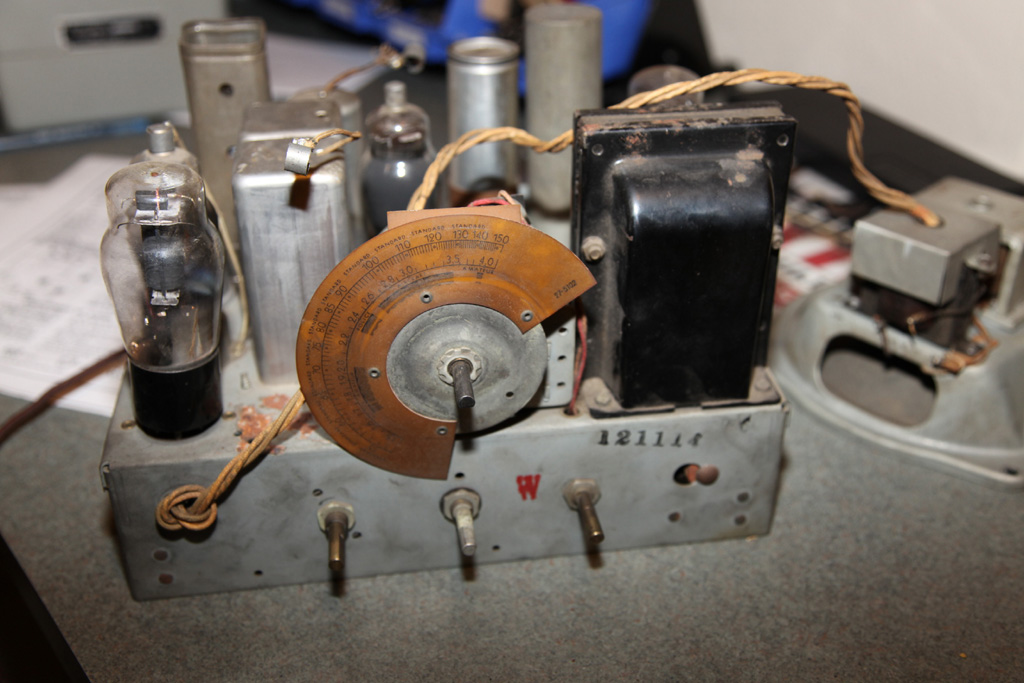
After, without tone ct installed.

People who do not drink, do not smoke, do not eat red meat will one day feel really stupid lying there and dying from nothing.
Posts: 13,776
Threads: 580
Joined: Sep 2005
City: Ferdinand
State, Province, Country: Indiana
Fine job. Yes, other than the coils, model 60 sets aren't too difficult to rebuild.
--
Ron Ramirez
Ferdinand IN
Posts: 1,889
Threads: 214
Joined: May 2015
City: Seattle
State, Province, Country: WA
Nice job Mike!
I've been lucky so far with respect to coils - but haven't worked on a 60 yet.
Congrats on getting yours rewound and working.
Posts: 16,533
Threads: 573
Joined: Oct 2011
City: Jackson
State, Province, Country: NJ
Mounted the tone ctl, and rebuilt the volume pot.
This one required drilling out the rivets to expose the power switch. I cleaned it (photos later), it was covered with soot. Now is fine.
The rivets had enough protrusion left to them for me to reuse them; seems sturdy. Also cleaned and lubed the resistive part.
The last one- the grommets. I will have lunch and then ho yo Lowe's trying to find something I could use.
I decided to try the electrolytics that are there now. They show good capacitance so there's hope.
Oh...and the tubes check.
People who do not drink, do not smoke, do not eat red meat will one day feel really stupid lying there and dying from nothing.
Posts: 16,533
Threads: 573
Joined: Oct 2011
City: Jackson
State, Province, Country: NJ
So I went, bough the grommets (took some grommets plus some spacers - this small cap has surprisingly thick grommets), installed the tuning cap, checked the tubes - all tested very good, assembled the radio, checked the transformer output, then put the rectifier in.
As I said, I left the electrolytics alone, they seemed good.
Turned it on, brought it slowly to 80V, then to 110V.
It started whistling but attempted the reception. Eventually I had some, than it went away.
It would start when I touched the cap's rotor and then go away as I released.
This prompted me that I forgot to solder the GND mesh wire to the cap.
After that it was all good.
Even the local station which is 1140 AM is...at 1140 AM. Considering the coils were rewound...not bad!
OK, it is singing. Or, rather, speaking - there is no music anywhere nearby somehow for now.
Last thing I did before I decided I have done enough today - blasted the band switch with Deoxit - it is scratchy and at the Police band the reception could come and then disappear and return after rocking the switch. BC band is solid though.
More pics:
The innyrds of the power switch: you can see the soot-covered contact.
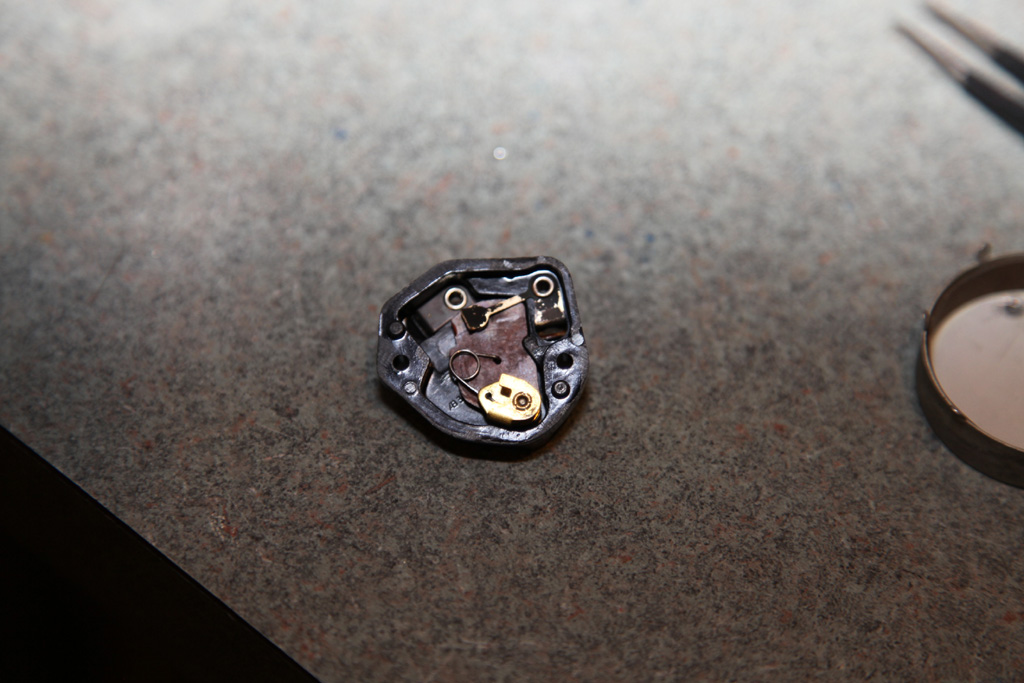
And the rest:
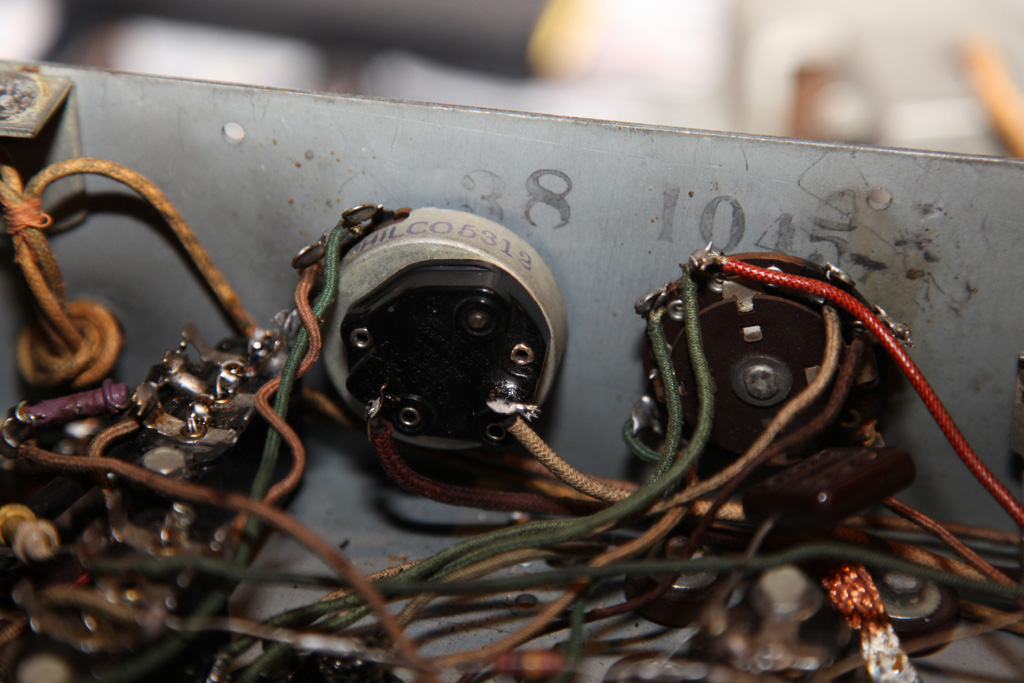
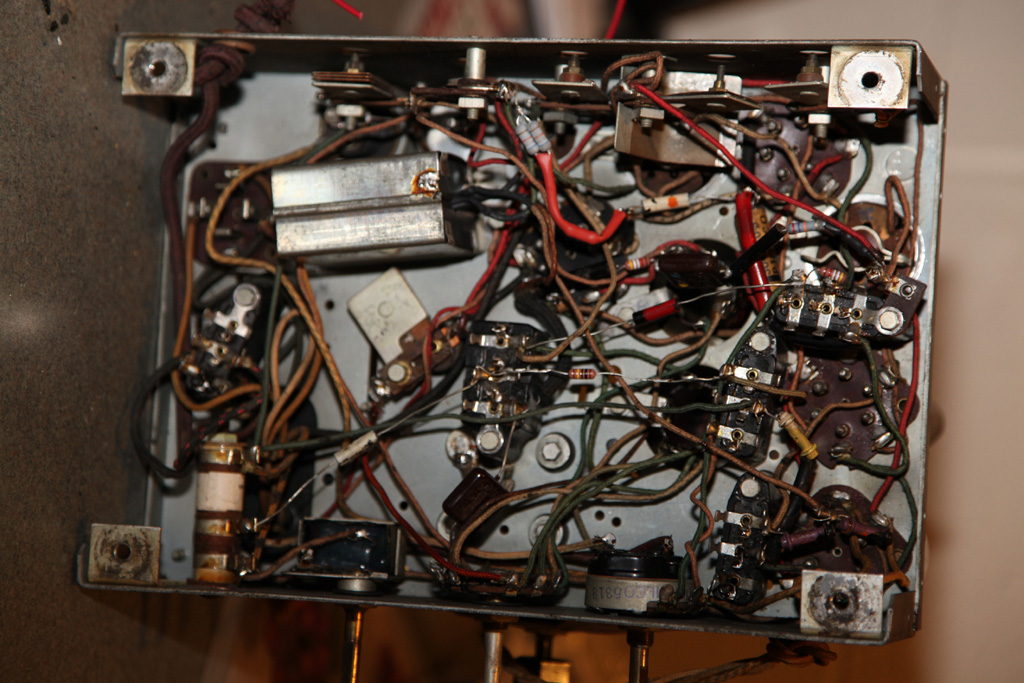
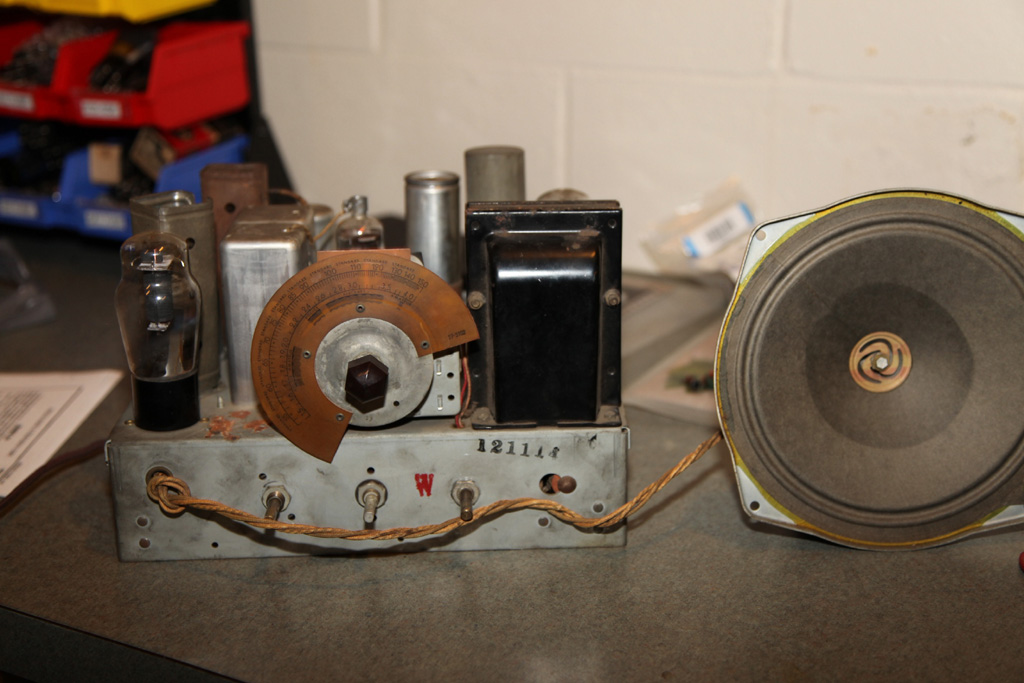
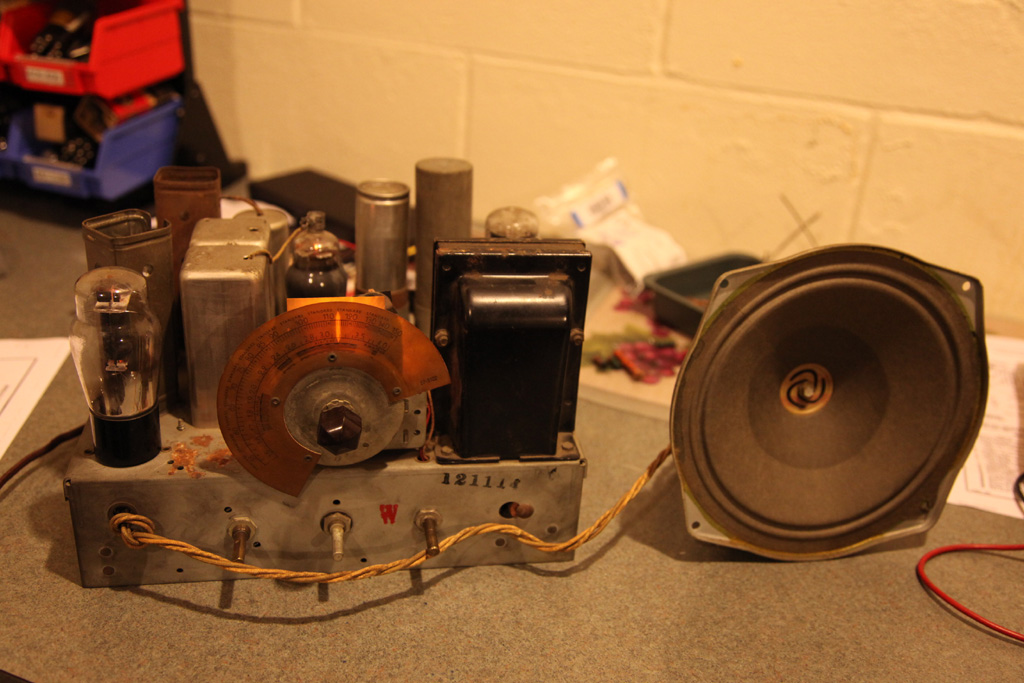
Alignment tomorrow.
People who do not drink, do not smoke, do not eat red meat will one day feel really stupid lying there and dying from nothing.
Posts: 933
Threads: 140
Joined: Mar 2015
City: Lansdale
State, Province, Country: PA
Nice Glad you were able to get it working..
Skip...
Users browsing this thread: 2 Guest(s)
|
|
Recent Posts
|
|
Philco newbie with P-1891-WA console questions
|
| Well, I've been stumped at trying to get the first of 11 electrolytic capacitors. I got a schematic and have a list of t...Jeffcon — 07:54 PM |
|
Model 80 Antenna Issue?
|
| Thanks Gary and Rod.
I also found an article in the Philco Repair Bench under Service Hints and Tips, about installi...Hamilton — 12:32 PM |
|
Model 80 Antenna Issue?
|
| Hello Hamilton, here is a little information found in our Philco Radio Library at the bottom of the Home page. Hope it ...GarySP — 11:28 AM |
|
Model 80 Antenna Issue?
|
| I did as you suggested and touching the middle of the volume control did nothing so the coil has to be rewound. Any idea...Hamilton — 10:19 AM |
|
1949 Motorola 5A9M
|
| This would be the second portable in the "other radios" forum where I have a similar one in my collection. I h...Arran — 12:41 AM |
|
Looking for any info: 1977 Ford-Philco Console Hi-Fi Turntable and Radio
|
| Hi PittsburgTost.
The record changer looks like a Garrard or BSR (Likely Garrard). The spindles just pull out and pu...MrFixr55 — 11:57 PM |
|
Looking for any info: 1977 Ford-Philco Console Hi-Fi Turntable and Radio
|
| Hello PittsburghToast ,
Welcome aboard and it looks like gary may have something for you !
now if I dig through my se...radiorich — 11:35 PM |
|
Model 80 Antenna Issue?
|
| You are kind of on the right path. You can touch the grid cap of the Detector/Oscillator 36 tube. I'm expecting a respon...RodB — 08:48 PM |
|
Looking for any info: 1977 Ford-Philco Console Hi-Fi Turntable and Radio
|
| Welcome to the Phorum, PittsburghToast! I found an old thread that my interest you regarding the quality and worth of P...GarySP — 08:48 PM |
|
Looking for any info: 1977 Ford-Philco Console Hi-Fi Turntable and Radio
|
| Welcome to the Phorum!
:wave:
We do not have anything on that unit in our digital library. There is a Sam's Photof...klondike98 — 08:47 PM |
|
Who's Online
|
There are currently 909 online users. [Complete List]
» 2 Member(s) | 907 Guest(s)
|
|
|

|
 
|



![[-] [-]](https://philcoradio.com/phorum/images/bootbb/collapse.png)


